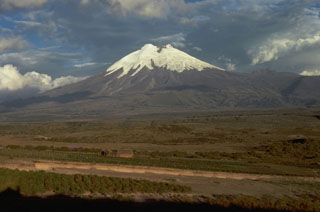Report on Cotopaxi (Ecuador) — 30 November-6 December 2022
Smithsonian Institution / US Geological Survey
Weekly Volcanic Activity Report, 30 November-6 December 2022
Managing Editor: Sally Sennert.
Please cite this report as:
Global Volcanism Program, 2022. Report on Cotopaxi (Ecuador) (Sennert, S, ed.). Weekly Volcanic Activity Report, 30 November-6 December 2022. Smithsonian Institution and US Geological Survey.
Cotopaxi
Ecuador
0.677°S, 78.436°W; summit elev. 5911 m
All times are local (unless otherwise noted)
IG reported that the low-level eruption at Cotopaxi continued during 30 November-6 December. At 0841 on 30 November the seismic network recorded a signal associated with an emission. A gas plume with low ash content was visible in webcam images rising 600 m above the summit and drifting E. Earlier in the morning minor ashfall was reported in Latacunga, though the ashfall may have been the result of remobilized material previously deposited. Daily steam-and-gas emissions during 1-6 December rose as high as 1.5 km above the summit and drifted E, SE, S, and W. Daily sulfur dioxide emissions measured by satellite during 1-4 December averaged 119-4,000 tons per day. On 2 December IG noted that the heights of gas-and-steam emissions had increased in the past few weeks, corresponding to greater gas output. Thermal anomalies in the crater were visible in recent days; one was visible on 1 November, and two were visible on each of the days of 28 and 29 November. Servicio Nacional de Gestión de Riesgos y Emergencias (SNGRE) maintained the Alert Level at Yellow (the second lowest level on a four-color scale).
Geological Summary. The symmetrical, glacier-covered, Cotopaxi stratovolcano is Ecuador's most well-known volcano and one of its most active. The steep-sided cone is capped by nested summit craters, the largest of which is about 550 x 800 m in diameter. Deep valleys scoured by lahars radiate from the summit of the andesitic volcano, and large andesitic lava flows extend to its base. The modern edifice has been constructed since a major collapse sometime prior to about 5,000 years ago. Pyroclastic flows (often confused in historical accounts with lava flows) have accompanied many explosive eruptions, and lahars have frequently devastated adjacent valleys. Strong eruptions took place in 1744, 1768, and 1877. Pyroclastic flows descended all sides of the volcano in 1877, and lahars traveled more than 100 km into the Pacific Ocean and western Amazon basin. Smaller eruptions have been frequent since that time.
Sources: Instituto Geofísico-Escuela Politécnica Nacional (IG-EPN), Servicio Nacional de Gestión de Riesgos y Emergencias (SNGRE)

